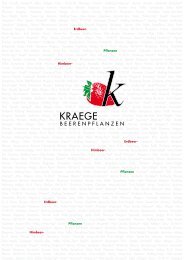Kraege_international_2019
You also want an ePaper? Increase the reach of your titles
YUMPU automatically turns print PDFs into web optimized ePapers that Google loves.
Raspberry<br />
Plants<br />
63<br />
Potted fresh plants<br />
The raspberry potted fresh plants<br />
pro duced by <strong>Kraege</strong> are raspberry<br />
plants as a result of propagation by<br />
cuttings. In order to produce this type<br />
of plant, root material is plan ted and<br />
cuttings are made from the young<br />
buds. The cuttings are placed in<br />
multi-cell plug trays where they take<br />
root. The potted fresh plants are delivered<br />
with substrate pellets 4 – 6 cm<br />
in size. This type of plant serves,<br />
among other things, as the starting<br />
material for the raspberry long cane<br />
production. Potted fresh plants are<br />
also good for establishing production<br />
areas in natural soil.<br />
Delivery of the plants<br />
The delivery of plants that have been<br />
ordered takes place according to<br />
prior agreement. As a rule, we need<br />
a few days to get the plants ready<br />
for dispatch. After receiving the<br />
plants, you should plant them as<br />
quickly as possible. If this isn’t possible<br />
due to bad weather conditions, the<br />
cases with the seedlings must be unloaded<br />
from the palettes and placed<br />
ideally in a semi-shaded area. The<br />
fact that you should regularly check<br />
the seedling cases and, if necessary,<br />
water them goes without saying. If<br />
the plants are well-cared for, the<br />
planting can be postponed for a few<br />
days.<br />
Planting<br />
After careful preparation of the soil,<br />
planting can be carried out starting<br />
in May. In order to achieve a sufficient<br />
cane height, all plants should be in<br />
the ground by mid-June. It is important<br />
that these delicate plants are<br />
de finitely planted so that they are free<br />
of frost.<br />
Watering the plants from overhead<br />
guarantees soil contact between the<br />
root balls and the natural soil. A consistent<br />
supply of water and nutrients<br />
is crucial in achieving the de sired<br />
cane length of 1.80 cm. Drip irrigation<br />
with appropriate fertilisation can<br />
ensure this. In this way, the basis for<br />
the yield potential in the following<br />
year can be laid in the year of planting.<br />
In order to control weeds, we<br />
recommend that foil or Mypex should<br />
be laid out before planting. If a ridge<br />
former is available, it is recommended<br />
to plant the potted green plants<br />
on dams. The faster warming of the<br />
dam stimulates the growth of roots<br />
and prevents water stagnation.<br />
Planting requirements<br />
In order to achieve high yields in the<br />
first crop year, a planting distance of<br />
6 plants per metre is recommended.<br />
The row distances result in the following<br />
number of plants per hectare:<br />
– 2,5 m = ca. 24.000 plants/ha<br />
– 3,0 m = ca. 20.000 plants/ha<br />
– 3,5 m = ca. 17.200 plants/ha<br />
– 4,0 m = ca. 15.000 plants/ha<br />
The distances between the rows<br />
should be chosen according to the<br />
technical equipment available.<br />
Besides the recommended distance<br />
between the plants to establish the<br />
production of the fruits, an appropriate<br />
trestle for breeding the canes must<br />
also be available.
















